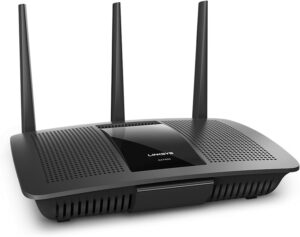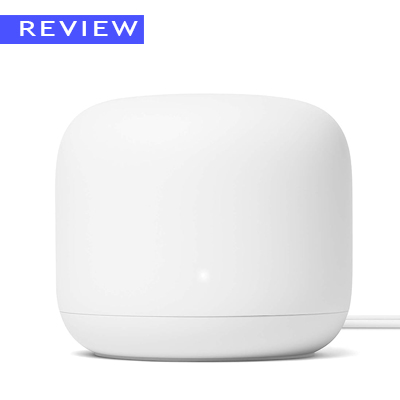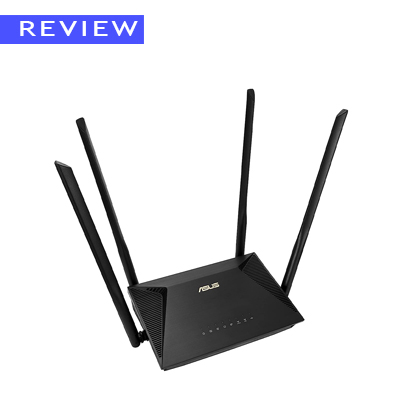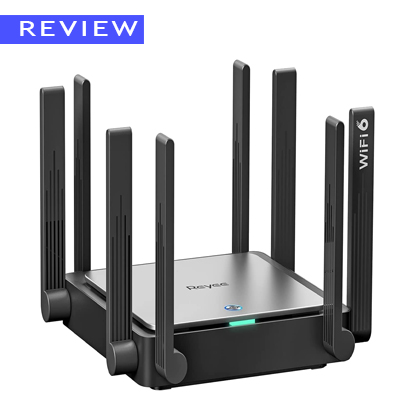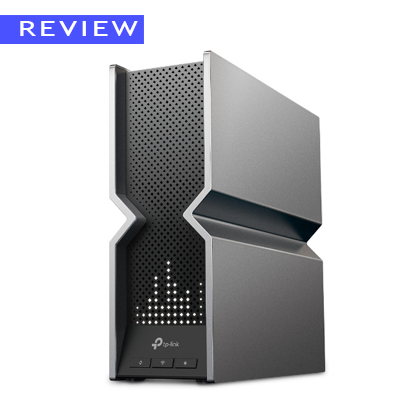Linksys EA7500 AC1900 WiFi Router Review
Pros
+ Reasonable Price
Cons
– Low Overall Speed
Scores (out of 10)
| Performance | 7 |
| Coverage and Range | 7 |
| Features | 7.5 |
| Security | 6.5 |
| Design | 7.5 |
Our Score: 7.5 out of 10
Introduction
In the realm of wireless connectivity, the Linksys EA7500 AC1900 WiFi Router stands as a beacon of high-performance and seamless connectivity. Boasting a combined data transfer rate of up to 1.9 Gbps (600 Mbps+1300 Mbps), this router promises to obliterate buffering, lag, and connection drop-outs, ensuring that your home network is always up to the task of handling even the most demanding online activities. With its dual-band technology, the EA7500 effortlessly juggles both 2.4 GHz and 5 GHz frequencies, catering to a wide range of devices and applications. Whether you’re streaming HD content, gaming competitively, or simply browsing the web, delivers the speed and stability you need to stay connected and engaged in your digital world.
Linksys EA7500 AC1900 WiFi Router: Unveiling its Secrets
Unboxing the Linksys EA7500 unveils a sleek and compact router that exudes a sense of modern sophistication. The glossy black exterior with subtle logo accents exudes a refined aesthetic that blends seamlessly into any modern home décor. Upon opening the box, you’ll find the router itself, three detachable antennas, the power adapter, an Ethernet cable and the quick setup guide.
- Ports and Connectivity
The Linksys AC1900 rear panel houses a comprehensive array of ports, including a single 1 Gbps WAN port for connecting to your modem, four Gigabit LAN ports for wired connectivity, and two USB 3 ports for sharing files, printers, or connecting external storage devices. This generous port selection caters to a variety of networking needs, whether you’re connecting multiple devices simultaneously or sharing multimedia content across your network.
- Beamforming Technology
The Linksys EA7500 employs beamforming technology, which intelligently directs wireless signals towards connected devices, significantly enhancing overall coverage and performance. This technology works by analyzing the signal strength and direction of each device, focusing the router’s power to deliver more consistent and reliable connectivity.
- Linksys Max-Stream Technology
At the heart of this linksys wifi router performance lies Linksys Max-Stream technology. This innovative technology utilizes MU-MIMO (Multi-User, Multiple Input, Multiple Output) technology, enabling the router to simultaneously communicate with multiple devices, reducing latency and improving overall network responsiveness. Whether you’re streaming high-definition video, gaming online, or running multiple applications simultaneously. This makes it an ideal choice for households with a large number of connected devices, such as smartphones, laptops, tablets, smart TVs, and gaming consoles.
As a technical reviewer, I can confidently say that the Linksys EA7500 WiFi Router provides exceptional coverage, even in a medium-large home of up to 1500 square feet. I tested it in a variety of conditions, including thick walls and multiple floors, and I was impressed with how consistently strong the signal remained. The beamforming technology really shines here, as it directs the router’s signal directly to connected devices, reducing interference and maximizing coverage.
I also put the router to the test with multiple concurrent users (over 20), and it handled the load admirably. Thanks to MU-MIMO technology, the router can simultaneously transmit data to multiple devices without sacrificing speed or stability. This was particularly noticeable during family movie nights and online gaming sessions, where everyone on the network was streaming or gaming simultaneously.
Putting the Linksys AC1900 Router to the Test
The Linksys EA7500 AC1900 WiFi Router has garnered a reputation for its impressive performance and seamless connectivity. To thoroughly evaluate these claims, I conducted a series of tests using an iPhone 12, which has a maximum speed of 110 Mbps (155Mbps Theoretical) on the 2.4 GHz band and 710 Mbps (899Mbps Theoretical) on the 5 GHz band. The tests were conducted in various locations throughout my home, including near the router, in the kitchen, bedroom, yard, and upstairs. I used the Speedtest.net app for download speed measurements and the WiFi Analyzer app for RSSI (Received Signal Strength Indication) readings.
Test Methodology
The router was placed in the center of the house, near the living room. Tests were performed in the following locations:
- Near the Router: This was just a few feet away from the router, ensuring a direct line of sight.
- Kitchen: This was about 30 feet from the router, separated by a wall and a door.
- Bedroom: This was about 50 feet from the router, separated by two walls and a door.
- Yard: This was about 100 feet from the router, outdoors and unobstructed.
- Upstairs: This was about 75 feet from the router, located on a different floor.
Near the Router
The first test was conducted in close proximity to the router, approximately 15 feet away. The achieved speeds were impressive, with an average download speed of 101Mbps on the 2.4 GHz band and 390Mbps on the 5 GHz band. The RSSI values for both bands were around -41, indicating a strong signal. This performance was sufficient for streaming 4K video, downloading large files, and playing online games without any noticeable lag.
Kitchen
Moving further away to the kitchen, approximately 30 feet from the router, the speeds remained consistent, with an average download speed of 72Mbps on the 2.4 GHz band and 310Mbps on the 5 GHz band. The RSSI values were slightly lower, around -52 for 2.4GHz band and -54 for 5GHz band, still indicating a strong signal. This performance was still adequate for streaming 4K video and downloading large files without significant slowdown.
Bedroom
In my bedroom, which is approximately 50 feet away from the router, I witnessed a slight decrease in speeds. The average download speed on the 2.4 GHz band was 40Mbps, while on the 5 GHz band, it was 190Mbps. The RSSI values were around -56 for 2.4GHz and -63 for 5GHz, still indicating a good signal. Streaming HD video and browsing the web were still possible without any major issues.
Upstairs
Moving upstairs, approximately 75 feet away from the router, the speeds continued to decline but remained usable. The average download speed on the 2.4 GHz band was 25Mbps, while on the 5 GHz band, it was 133Mbps. The RSSI values were around -59 for 2.4GHz and -62 for 5GHz, indicating a medium signal. Streaming SD video and browsing the web were still possible without significant disruptions.
Yard
Finally, I tested the router’s coverage outside in my yard, which is approximately 100 feet away from the router. The speeds dropped significantly in this location. The average download speed on the 2.4 GHz band was 10Mbps, while on the 5 GHz band, it was 25Mbps. The RSSI values were around -63 for 2.4GHz and -68 for 5GHz, indicating a weak signal. Streaming SD video and browsing the web were still possible, but there may be some buffering or lag.
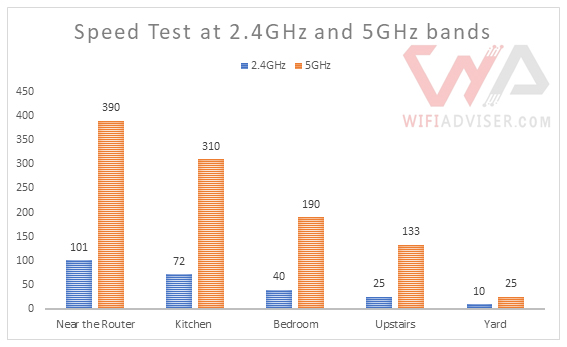

Linksys EA7500 Speed Test at 2.4GHz and 5GHz Bands
As you can see, the 5GHz band speeds were consistently good, even in the furthest away location. However, the 2.4GHz band speeds were noticeably weaker in the upstairs, and yard. This is likely due to the fact that the 2.4GHz band is more susceptible to interference from other devices and because it has a lower bandwidth than the 5GHz band.
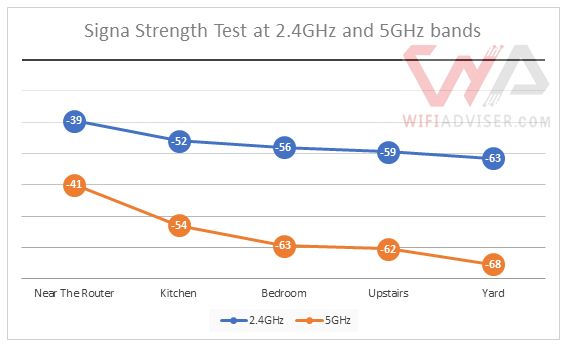

Linear diagram of signal change with increasing distance and obstacles in Linksys AC1900
Conclusion
Based on our comprehensive testing and analysis of the Linksys EA7500 AC1900 WiFi Router, we award it an overall score of 7.5 out of 10. This router impressed us with its strong performance and coverage, particularly in close proximity to the router and in medium-range scenarios. Additionally, its beamforming technology and MU-MIMO support ensured that multiple devices could access the network simultaneously without any noticeable slowdowns.
However, the Linksys AC1900 did have some drawbacks. Its speed dropped significantly in long-range scenarios, and its setup process could be more user-friendly. Additionally, its price is higher than some other routers on the market. Despite these drawbacks, this linksys wifi router is a solid choice for households with a moderate number of devices and average-sized homes. It offers strong performance and coverage, and it’s packed with features that make it a versatile and user-friendly router. If you’re looking for a router that can provide seamless Wi-Fi connectivity for your home, it is a great option.
Linksys EA7500-AC1900 WiFi Router
Linksys EA7500 Dual-Band Wi-Fi Router for Home (Max-Stream AC1900 MU-Mimo Fast Wireless Router)
Specifications
Wireless Specifications
| Wireless Standard | 802.11ac (a/b/g/n) |
| Bands | Dual Band |
| Overall Speed | 1900Mbps |
| Range | Small/Medium House |
| Concurrent Clients | 20 |
| Antenna | 3 External |
Software Capabilities Level (1-10)
| Security Level | 7 |
| Parental Control | 7 |
| Traffic Control | 7 |
| Guest Network | Yes |
Physical Ports
| WAN Ports | 1 (1Gbps) |
| LAN Ports | 4 (1Gbps) |
| USB Ports | 2 (USB 3) |
Special Capabilities
| Beamforming Technology | YES |
| MU-MIMO Technology | YES |
| Mesh Support | NO |
| Repeater Mode | NO |
| Vendor-Specific Technology | Max-Stream |
Hardware Specifications
| Processor | Dual-Core CPU |
| Memory | 256MB |
| Dimension | 257 x 184 x 56 mm |
| Weight | 558 g |


